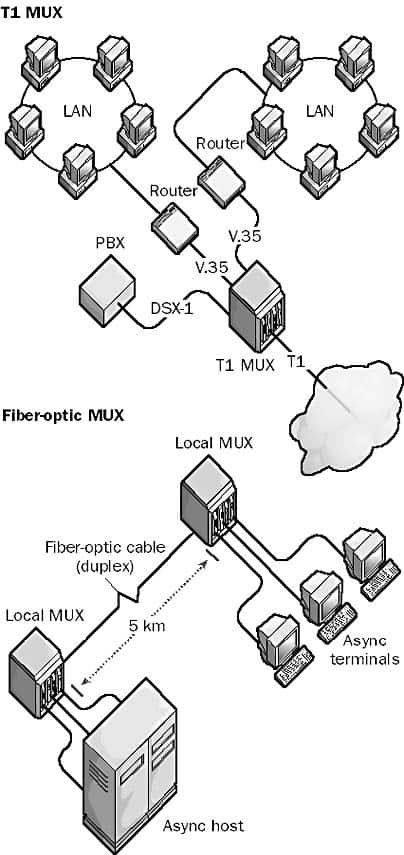Imagine you’re at a bustling train station, where dozens of trains need to share the same track to reach their destinations efficiently. A Multiplexer, or MUX, operates under a similar principle in the world of telecommunications, acting as a railway switch operator. It combines multiple data signals from various sources (your trains) and sends them over a single line (the track), optimizing space and resources without the data colliding into each other.
Table of Contents:
- The Grand Central of Data
- A Day in the Life of Max the Multiplexer
- The Unexpected Rush Hour
- Crisis Averted and Lessons Learned
- Conclusion
- Want to Learn the Traditional Way? Here is the old article!

1. The Grand Central of Data
In the vibrant digital metropolis of DataTown, there’s a critical juncture that never sleeps—the Grand Central MUX. Here, in this humming nexus, data from myriad devices across the city gather, each vying for a spot on the singular, high-speed line that stretches like a digital superhighway to the far reaches of the Internet.
Barry the Blog is a frequent visitor, always bustling in with timely updates and hot takes on the latest trends. With his quick pace and constant stream of information, Barry needs a fast track to the web to ensure his readers catch every story as it unfolds. Beside him, often shimmering with colors, is Greta the GIF. Greta brings a lighter touch to the platform, carrying loops of laughter and splashes of color designed to brighten anyone’s screen.
On this particular day, the station buzzes with more activity than usual. A local sports final has everyone in DataTown eager to share moments, memes, and multimedia celebrations. The air is thick with digital anticipation, and the usual calm orchestration of data flow is now a bubbling pot of urgency.
At the heart of all this is Max the Multiplexer, the seasoned conductor of Grand Central MUX. Max’s role is pivotal; he directs the data from Barry, Greta, and countless others into organized, efficient queues, ensuring that each packet of data can hop onto the main line without a hitch. His tools are simple but powerful: LEDs blink and screens flash as he monitors the flow and adjusts the routes.
The layout of Grand Central MUX is a sight to behold. Imagine a sprawling array of glowing pathways, each marked with signs for different types of data: Email Express, Video Voyage, Social Media Stream, and many more. Each lane merges into a main artery, the Fiber Optic Freeway, which carries the town’s digital lifeblood at the speed of light.

Barry and Greta, despite their differences, know the drill well. They position themselves at the starting blocks of their respective lanes, Barry tapping impatiently as he uploads his latest piece, and Greta double-checking her pixels to ensure she looks her best for the journey. They nod at Max, who’s already busy at the controls, coordinating this ballet of bytes with the precision of a maestro.
But today, with the surge of data from the sports final, Max must maneuver with extra care. His usual smooth orchestration faces the crescendo of rush hour. The challenge? To maintain harmony and prevent a cacophony of colliding data. As the clock ticks, the pressure mounts, setting the stage for a day at Grand Central MUX that none of them will soon forget.
2. A Day in the Life of Max the Multiplexer
The sun barely peeks over the horizon, but Max the Multiplexer is already gearing up for a day that promises a whirlwind of digital activity. With a steaming cup of java in hand—his “liquid RAM,” he jokes—Max prepares to orchestrate the flow of DataTown’s communications through the single conduit that binds them to the broader digital world.
As Max settles into his command chair, the buzz of the early morning commuters starts to fill the airwaves. Barry the Blog’s latest articles need to hit the East Coast before the morning rush, and Greta the GIF has a new animation celebrating the local team’s victory—both high priority. Max’s control panel lights up like a Christmas tree, each light representing a stream of data waiting to be channeled through the fiber optic freeway.

Today, Max employs Time Division Multiplexing (TDM), a technique he likens to a highly disciplined train schedule. He explains, “Think of it like assigning a specific train to a specific track at a specific time. Each data type gets a slot, and they take turns so everyone gets through without bumping into each other.” With TDM, Max ensures that urgent news updates, leisurely browsed social media feeds, and real-time sports broadcasts coexist peacefully, each allocated precise intervals to transmit their data packets.
But as the city wakes up, the demands surge. The sports final has not only regular fans buzzing but also attracts a global audience, all eager to share in the glory or groan in collective disappointment. Video streams, heavier and more demanding, begin to dominate the traffic, threatening to overwhelm the meticulously planned schedule.
3. The Unexpected Rush Hour
Just as Max is fine-tuning the day’s data streams, an influx of high-resolution video streams from the sports final floods the system. It’s the digital equivalent of every train in the country arriving at Grand Central MUX at once. The predictable patterns of morning emails and routine data checks are drowned out by this tidal wave of pixels and playbacks.
Max’s usual calm demeanor is tested as he scrambles to adapt to this surge. He quickly switches from the rigid timetable of TDM to the more fluid and dynamic approach of Statistical Multiplexing. This technique, Max explains, is like “judging which trains are carrying the most passengers and giving them a faster track.” Here, data packets are prioritized based on their size and necessity; larger packets like video streams get preference over smaller, less urgent ones.
Using sophisticated algorithms, Max starts analyzing the data traffic in real-time. His screens flicker with simulations and predictions, helping him decide which data streams need immediate clearance and which can afford a slight delay. Barry’s blog posts are compact and can fit into smaller gaps, while Greta’s GIFs, though visually demanding, are less time-sensitive and can wait a few milliseconds more.

Max’s quick thinking and agile management keep the data flowing. He reroutes some of the smaller packets through less congested pathways, ensuring they will still arrive on time, just via a scenic route. Meanwhile, the video streams, now prioritized, rush through the main channels, delivering crisp, live-action shots to viewers worldwide.
As the day progresses, the digital rush hour begins to ebb, and Max’s control room returns to its normal rhythm. The crisis may have passed, but the lessons linger, highlighting the need for flexibility and adaptability in the ever-evolving landscape of digital communication.
4. Crisis Averted and Lessons Learned
As the digital sun sets over DataTown, Max the Multiplexer takes a well-deserved breath. The rush of the sports final has subsided, and the data flows are returning to their normal, rhythmic pulses. Barry’s articles have been delivered, Greta’s GIFs are looping joyously across screens, and the fans have relived the game’s best moments through smooth, uninterrupted video streams.
Reflecting on the day’s events in the calm of his control center, Max considers the lessons of this unexpected digital deluge. The surge had tested every protocol and pushed every system to its limits, but Max’s quick shift to statistical multiplexing had been the key to navigating the chaos. It was a reminder of the importance of not just having tools, but understanding deeply when and how to use them.
Max knows that today’s solutions might not suffice tomorrow. The world of data is a landscape in constant flux, with new technologies, increasing demands, and unexpected surges. Today, more than ever, flexibility and adaptability are as crucial as the infrastructure itself. Max ponders investing in more advanced predictive analytics and automated systems that can adapt in real-time, reducing the need for manual intervention and allowing for more seamless data flow management.
5. Conclusion: The Unseen Hero
Back in the quiet of the night, as DataTown sleeps, the digital highway at Grand Central MUX hums softly. Max the Multiplexer, the unsung hero of the digital age, watches over it with a vigilant eye. His day had been a testament to the invisible yet critical role multiplexers play in our interconnected lives.
Just as the trains of yore couldn’t run without their switch operators, our modern digital world relies on the quiet work of technologies and people like Max. They ensure that every bit of data—from the urgent to the trivial—finds its path smoothly and efficiently, even when the tracks are swamped by the weight of a thousand videos.
So, the next time you click on a link, stream a video, or send an email, spare a thought for the Maxes of the world and the multiplexers they command. They are the maestros of the data symphony, orchestrating a ballet of bytes that dances unseen beneath the activities of our daily digital lives.
In our journey through the bustling hubs of data like Grand Central MUX, we’ve seen the drama of the rush hour and the quiet victory of crisis averted. Remember, in the vast narrative of the internet, every packet of data has a story, and every multiplexer is a storyteller, ensuring the tale continues, one byte at a time.
6. The Old Article!
6.1 What is a Multiplexer?
A multiplexer is a telecommunications device that multiplexes several data channels from different pieces of data terminal equipment (DTE). Multiplexers (MUXes) are frequently used to combine digital lines in order to save cost by eliminating the need for extra line termination devices such as CSU/DSUs (Channel Service Unit/Data Service Units).
For example, a T1 MUX might have several V.35 interfaces for accepting incoming data from bridges or routers connected to your local area networks (LANs) plus a DSX-1 interface for connecting to a channel bank or private branch exchange (PBX) system.
6.2 How do Multiplexers Work?
The MUX takes the serial data input and voice input and multiplexes them together into a single data stream using an integrated CSU/DSU for direct transmission over a T1 line, allowing you to use your T1 line for voice and data combined. You can use a similar device to multiplex data and voice for transmission over a public frame relay carrier network.
MUXes are often used in mainframe environments for connecting remote terminals to async hosts without the need for individual cabling for each terminal. These types of MUXes are generally used in pairs and combine channels using time-division multiplexing (TDM). Examples include the following:
- Fiber-optic MUXes for combining several sync or async data channels onto one duplex fiber-optic cable. A typical fiber-optic MUX might have 12 or 24 RS-232 input ports and support speeds in excess of 115.2 Kbps per channel. These MUXes are typically used in pairs to connect remote terminals to an async mainframe host across a campus environment and are often referred to as short-haul or local MUXes.
- Twisted-pair MUXes for multiplexing several RS-232 serial channels over installed RJ-11 wiring to save costs.
- Coax MUXes for connecting several 3270 terminals to an IBM controller in order to reduce the costs of cabling.
You can use an Ethernet MUX to take the output of several ports from a 10-Mbps Ethernet switch and transmit the time-division multiplexed signals over a single fiber-optic cable at distances up to 2 kilometers. These MUXes are also typically used in pairs.

6.3 Inverse Multiplexer
An inverse multiplexer, or IMUX, takes a single input data channel from a DTE such as a router and spreads it to several digital transmission lines. A demultiplexer is a MUX at the remote end of a multiplexed communication system.
6.4 Advanced T1 MUX
Advanced T1 MUXes often offer some management functions. For example, you can configure a MUX with Simple Network Management Protocol (SNMP) to send a trap to your SNMP management console when a problem occurs. Some MUXes can also remote-dial a number using a built-in modem. A modular MUX allows you to expand your wide area network (WAN) link as your network grows by adding modules to provide additional V.35, RS-232, or RS-530 input ports.